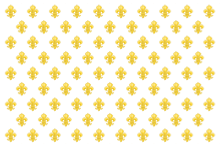Dukes in France
| Duke | |
|---|---|

The drapeau blanc or standard of the French royal family
|
|
| Peerage | France |
The title of Duke was the highest title in the French nobility during the time of the monarchy in France.
The highest precedence in the realm, attached to a feudal territory, was given to the twelve original pairies, which had originated in the Middle Ages and also had a traditional function in the royal coronation, comparable to the German imperial archoffices.
Half of them were Dukes and half of them Counts. Of these, three were ecclesiastical and three were secular. Of these twelve, the prelates all ranked above the secular peers of the realm and three temporal, and the dukes all ranked above the counts.
The Prince-Bishops with ducal territories included:
Later, the Archbishop of Paris was given the title of duc de Saint-Cloud with the dignity of peerage, but it was debated if he was an ecclesiastical peer or merely a bishop holding a lay peerage.
Under the House of Capet there were five laic duchies:
At the end of the 13th century, the King elevated some counties into duchies, a practice that increased through the early modern period until the French Revolution. Many of this duchies were also peerages, so-called new peerages.
Ducal titles traditionally held by princes of the royal blood:
Other notable ducal titles:
The title of Duke of France refers to the rulers of the Île de France, informally Francia. The dynasts of Robert the Strong's family are usually termed "Dukes of France" and their title evolved into the name for the French nation after one of their members, Hugh Capet, ascended the throne. Since the end of the monarchy, it has been used by pretenders to the French throne such as Prince Henri, Count of Paris.
...
Wikipedia
